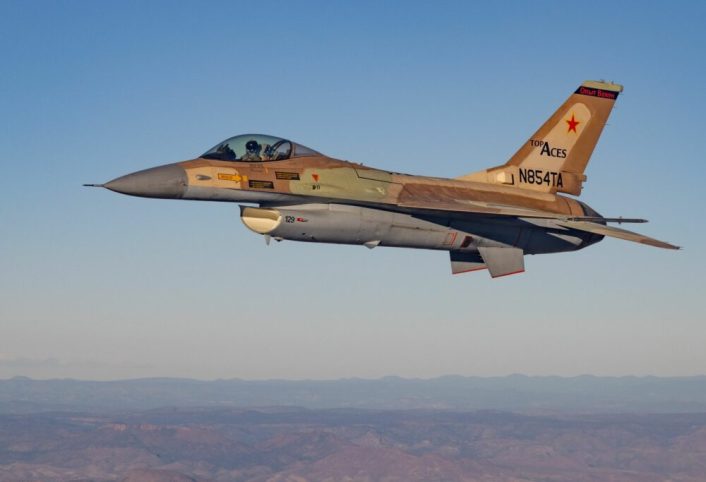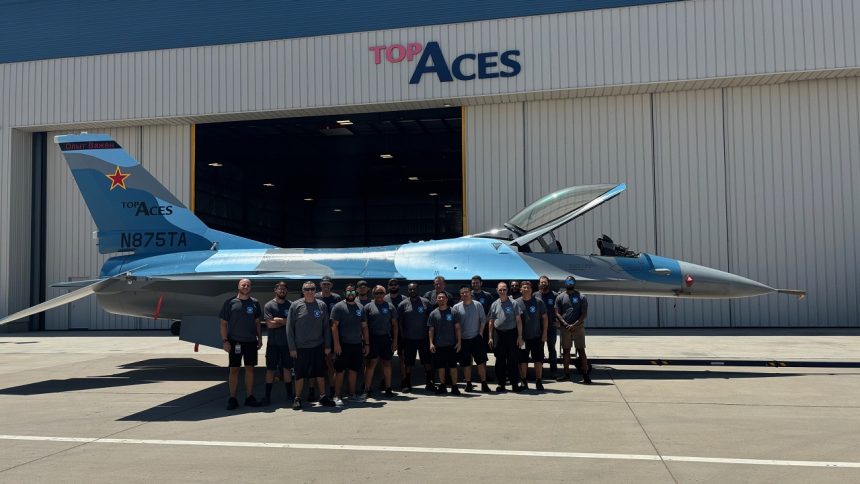The Flanker Blue F-16 will join Top Aces’ fleet of former Israeli jets that are used to provide adversary air for the U.S. Air Force’s training.
Top Aces has just unveiled its first F-16 painted in the Flanker Blue paint scheme which will joint the fleet used to provide adversary aircraft for the training of U.S. Air Force’s pilots. Top Aces Corp. is one of the firms that was awarded contracts under the Combat Air Forces (CAF)/Contracted Air Support (CAS) program to improve the training of the U.S. Air Force’s Formal Training Units (FTU) and increase the number of new pilots trained.
For this role, the company employs former Israeli F-16A Netz (Hawk), as they are locally known, which were retired from the Israeli Air Force at the end of 2016 and were delivered in the US in 2021. Until now, Top Aces maintained a paint scheme similar to the one which these aircraft used while still in service in Israel.
The new Flanker Blue paint scheme is inspired by the one used by some F-16s of the Air Force’s 64th Aggressor Squadron at Nellis Air Force Base, Nevada. It is unknown if Top Aces will replicate other paint schemes in addition to the Flanker Blue.
Our #TopAces Corp. team in Mesa, AZ is proud to present our first F-16 aircraft sporting the sleek Flanker Blue paint scheme! N875TA will join our fleet of high-performance F-16 aggressors and provide mission-critical training to USAF 5th Gen pilots.
Let us know what you think! pic.twitter.com/f5m82CE805
— Top Aces (@topaces) August 19, 2024
Top Aces’ F-16s
Top Aces Corp. received in 2021 the first four F-16 Fighting Falcons, out of a total order of 29 aircraft, bought from the Israeli Air Force. The aircraft were upgraded throughout the years in Israel, however it’s unknown in which configuration they were delivered. In either case, Top Aces later upgraded the aircraft before introducing them in service.
The aircraft are equipped with Top Aces’ proprietary Advanced Aggressor Mission System (AAMS), which allows the F-16 to replicate any near-peer adversary fighter aircraft. In addition to the AAMS, the F-16s are equipped with Active Electronically Scanned Array (AESA) radars, Scorpion Helmet Mounted Displays, datalinks, electronic countermeasures and so on. The weapons are only simulated, and the F-16s are always seen flying in a clean configuration.
Check out #TopAces as we air-to-air refuel with the #F35‘s of 33 Fighter Wing and 58FS at Eglin Air Force Base (@teameglin) during an ADAIR training sortie!#F16 #airtoair #refuel #usaf #fighterjet #fighterpilot #pilot #pilottraining #military #militrytraining #ExperienceMatters pic.twitter.com/2gJ9oQyVI2
— Top Aces (@topaces) August 13, 2024
These capabilities, together with the performance of the F-16, will surely be much valued while simulating higher end 4th and 5th generation threats that US pilots may have to face in the future. Other private adversary aircraft currently available, like the Mirage F1, F-5 Tiger, A-4 Skyhawk and Hawker Hunter, while deeply upgraded in some cases, are still somewhat limited by their older airframes and systems.
The acquisition of the F-16 made Top Aces the first private operator to field 4th gen aircraft for the contracted adversary air services. The company first received a first contract in 2019 to “provide complete contracted air support services for realistic and challenging advanced adversary air threats and close air support threats”, as part of the Combat Air Force/Contracted Air Support (CAF/CAS) program.
Another contract was later awarded in 2022 to provide training for pilots at Eglin AFB and Luke AFB, with the press statements specifically mentioning F-22 and F-35 pilots among the others.

Contracted Red Air
In recent years, the privatization of military training has seen a significant growth, with private companies increasingly stepping in to provide “Red Air” adversary services, where they simulate enemy aircraft and tactics during training. The presence of contracted Red Air is now an integral part of both daily training and major exercises.
The use of contracted “Red Air” services allows the Air Force to focus the resources on other aspects of the operations while still maintaining a high level of training. Before the advent of these contracted services, usually squadrons had to provide aircraft and resources to also generate “Red” aircraft during training missions.
The high quality of the training is granted by the contractors employing many experienced former military pilots, which bring their knowledge and expertise. Some of these pilots were also part of the Air Force and Navy Aggressor squadrons, which have specialized training to replicate adversaries.









